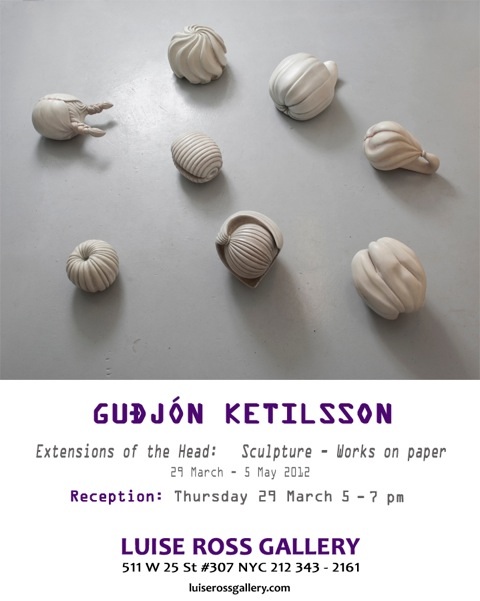Gudjon Ketilsson – Extensions of the Head
Luise Ross Gallery
511 West 25 Street #307
Chelsea, New York
March 29th – May 5th 2012
www.luiserossgallery.com
Opening reception: Thursday, March 29th from 5-7pm
Guðjón Ketilsson (1956)
Lives in Reykjavík, Iceland
Guðjón Ketilsson studied Fine Art at the Academy of Icelandic Art and at Nova Scotia College of Art and Design, Canada.He mainly works with drawing and sculpture, mostly from wood. The human body is central to his works, its absence and/or its very presence.His study of the human condition is through its primary vehicle, the body. He explores time, memory and history through details of our everyday connection to our own bodies, from our clothing and hairdos, to shoes that change and adjust to the size, temperature and movement of the body.
Ketilsson has had over thirty solo-shows and has participated in numerous group-shows in Iceland and internationally, such as in the Nordic countries, The Netherlands, Spain, USA, Canada, China and Australia. His works can be found in the collections of the major Icelandic art museums and some abroad, as well as in private collections. He has participated in various international residencies and has been selected for numerous competitions of art in public spaces. Ketilsson received the DV-Cultural Prize in 2000 and the Einar Jónsson Art Museum Award in 2001, in Iceland.
Extensions of the Head
The human body is central to Ketilsson´s works, its absence and its very presence. His study of the human condition is through its primary vehicle, the body. He explores time, memory and history through details of our everyday connection to our own bodies, from our clothing and hairdos, to tools, prosthetics and shoes that adjust to the volume, temperature and movement of the body.
In this exhibition, Ketilsson explores the body from three angles, how the seeing body relates to the sensing body, and the symbolic body:
- Sensory experiences of one´s own body; fragments of the artist´s own body, such as seen in the pencil drawings.
- Perception of and relation to other bodies; the body of the people in his everyday surrounding, such as the floor sculptures and wall reliefs inspired by the hair of among others his children.
- The symbolic body; the human body as it has been presented in art history through the ages, such as in the large, multi-piece wall relief.
The works in this exhibition span a period from 2000 until today and the three dimensional works are presented for the first time, at Luise Ross Gallery.
The Self-Portraits
The pencil drawings show the artist´s observations of his own body, selected parts that, like tree-rings, reflect time passed and keep record of bodily experiences. One looks for references, what directs his selection of body parts? Does he observe parts of the body that relate to specific emotions? Ketilsson has made self-portraits, in the form of painting and sculpture, since the beginning of his career, an ever expanding archive of self-reflection through imagery.
The Hair Sculptures
The reasons as to why the faces of the artist, often his children, the commissioner and his family members, appear in Renaissance art, and in fact in art still today, can be related to the societal role of the artist as one who observes and analyzes all aspects of life, such as the body as an esthetic, scientific, political, symbolic, perishable/worldly, eternal/godly, perfect/imperfect, destructor/ creator, and constructs a form combining these elements, which itself becomes eternal. The floor- and wall sculptures titled “Hair” take their forms from the hair arrangements of the artist´s children and other people familiar to him, and are then abstracted. For Ketilsson, they are portraits of specific people, as well as a more general exploration of societal status as signified by hairdo´s, and hair as a cultural, historical means of self-presentation.
The Headwear
Among Ketilsson´s many works referential to Western art history is a wall installation titled “Peasant Wedding”, a direct continuation from a 16th century painting, bearing the same title, by Flemish Renaissance painter Peter Brueghel the elder. What interests Ketilsson about this particular work is the readable social status and physicality of the headwear seen in the painting. He extracts the headwear and carves out into three dimensional objects, abstract forms that become figurative when assembled and seen in the context of art history. There is a strong relation between this work and many of Ketilsson´s other works for which he extracts selected parts of garments covering a body that is signified with that very same garment, throughout symbolic orders of religious manifestations, as seen in Western art history.
The body, this most classical subject of art and philosophy never seizes to be of interest as it is at the core of our existence and the body as a political space is constantly challenged. The body is everything and nothing, mysterious and yet scientifically mapped, fragile and strong. One presses a point on the sole of the foot, and feels it immediately on the side of the chest. The body is a metaphor for dualisms, the in-itself of the for-itself. We do not really know our own body and it is only partially ours, borrowed for a fragment in time.


Comments
article Next
article